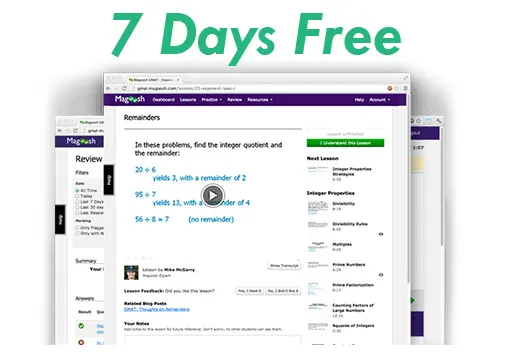Hello,
For Question 2 here, I am thinking that CPI-U for electricity in July was 0.5 and in August it was 0.7 due to the 0.2 increase. Hence, %age increase is 40%. Is this correct?
For Question 3, the OA says that there was change in the CPI-U from May 2010 to Sep. 2010. Since it is 0 for May and Sep 2010 I was not clear. Can you please explain this?
OA: Yes No No
Thanks a lot,
Sri
Consumer Price Index (CPI) measures the average prices of
This topic has expert replies
-
gmattesttaker2
- Legendary Member
- Posts: 641
- Joined: Tue Feb 14, 2012 3:52 pm
- Thanked: 11 times
- Followed by:8 members
GMAT/MBA Expert
- [email protected]
- Elite Legendary Member
- Posts: 10392
- Joined: Sun Jun 23, 2013 6:38 pm
- Location: Palo Alto, CA
- Thanked: 2867 times
- Followed by:511 members
- GMAT Score:800
Hi Sri,
The description at the top of the table reads "Seasonally adjusted changes from the PRECEDING MONTH", which means that the number in the box is the percent increase/decrease in price of an item relative to the prior month.
For question 2, the CPI-U for electricity in July was 0.5; this means that the price of electricity was .5% HIGHER in July than in June. The CPI-U for electricity in August was 0.2; this means that the price of electricity was .2% HIGHER in August than in July. This statement asks if the increase from July to August was .5% higher. This means that the answer to this question is NO.
For question 3, we need to look at the CPI-U for "all items less food and energy." This statement asks if there was NO CHANGE from May through September. We can see from the table that there were 3 "changes" (in May, June and July), so the answer to this question is NO.
GMAT assassins aren't born, they're made,
Rich
The description at the top of the table reads "Seasonally adjusted changes from the PRECEDING MONTH", which means that the number in the box is the percent increase/decrease in price of an item relative to the prior month.
For question 2, the CPI-U for electricity in July was 0.5; this means that the price of electricity was .5% HIGHER in July than in June. The CPI-U for electricity in August was 0.2; this means that the price of electricity was .2% HIGHER in August than in July. This statement asks if the increase from July to August was .5% higher. This means that the answer to this question is NO.
For question 3, we need to look at the CPI-U for "all items less food and energy." This statement asks if there was NO CHANGE from May through September. We can see from the table that there were 3 "changes" (in May, June and July), so the answer to this question is NO.
GMAT assassins aren't born, they're made,
Rich
-
gmattesttaker2
- Legendary Member
- Posts: 641
- Joined: Tue Feb 14, 2012 3:52 pm
- Thanked: 11 times
- Followed by:8 members
Hello Rich,[email protected] wrote:Hi Sri,
The description at the top of the table reads "Seasonally adjusted changes from the PRECEDING MONTH", which means that the number in the box is the percent increase/decrease in price of an item relative to the prior month.
For question 2, the CPI-U for electricity in July was 0.5; this means that the price of electricity was .5% HIGHER in July than in June. The CPI-U for electricity in August was 0.2; this means that the price of electricity was .2% HIGHER in August than in July. This statement asks if the increase from July to August was .5% higher. This means that the answer to this question is NO.
For question 3, we need to look at the CPI-U for "all items less food and energy." This statement asks if there was NO CHANGE from May through September. We can see from the table that there were 3 "changes" (in May, June and July), so the answer to this question is NO.
GMAT assassins aren't born, they're made,
Rich
Thank you very much for the excellent explanation.
Best Regards,
Sri
-
Boredguy1543
- Newbie | Next Rank: 10 Posts
- Posts: 5
- Joined: Tue Oct 13, 2015 5:32 pm
I hated this question, since I got it wrong. The reason I got it wrong was the wording of the question. It clearly states ' For each following, select YES if the statement is INFERABLE from the given information. ' So basically, I thought it was like Data Sufficiency where we didn't need to solve it, and see if we have the information to solve it. So for the first question, I clicked yes instead of no, since there's information that you can obtain from it to get the right answer.gmattesttaker2 wrote:Hello,
For Question 2 here, I am thinking that CPI-U for electricity in July was 0.5 and in August it was 0.7 due to the 0.2 increase. Hence, %age increase is 40%. Is this correct?
For Question 3, the OA says that there was change in the CPI-U from May 2010 to Sep. 2010. Since it is 0 for May and Sep 2010 I was not clear. Can you please explain this?
OA: Yes No No
Thanks a lot,
Sri
-
crescendo85
- Junior | Next Rank: 30 Posts
- Posts: 18
- Joined: Sat Feb 13, 2016 1:37 am
- Thanked: 1 times
Hello Rich
Small confusion.
For each following, select YES if the statement is INFERABLE from the given information else select NO.
Shouldnt answer be YES for all these 3 answers. Its not a true false question. It just asks you if the information is sufficient to answer these.
Small confusion.
For each following, select YES if the statement is INFERABLE from the given information else select NO.
Shouldnt answer be YES for all these 3 answers. Its not a true false question. It just asks you if the information is sufficient to answer these.
- DavidG@VeritasPrep
- Legendary Member
- Posts: 2663
- Joined: Wed Jan 14, 2015 8:25 am
- Location: Boston, MA
- Thanked: 1153 times
- Followed by:128 members
- GMAT Score:770
"Inferable" and "sufficient to answer" are not the same thing. Take a simple example. Say x = 9. This would be sufficient to answer the question "Is x prime?" However, if we were asked, "Can we infer that x is prime?" the answer is "no," we can't. So to summarize: Sufficient = we definitively know the answer to the question. Inferable = we can deduce that the statement in question is true.crescendo85 wrote:Hello Rich
Small confusion.
For each following, select YES if the statement is INFERABLE from the given information else select NO.
Shouldnt answer be YES for all these 3 answers. Its not a true false question. It just asks you if the information is sufficient to answer these.
- DavidG@VeritasPrep
- Legendary Member
- Posts: 2663
- Joined: Wed Jan 14, 2015 8:25 am
- Location: Boston, MA
- Thanked: 1153 times
- Followed by:128 members
- GMAT Score:770
See here for another example in which a test-taker was struggling to differentiate between inferable and sufficient - this may help clarify the distinction: https://www.beatthegmat.com/ir-inferenc ... 88804.html
-
crescendo85
- Junior | Next Rank: 30 Posts
- Posts: 18
- Joined: Sat Feb 13, 2016 1:37 am
- Thanked: 1 times
Thanks for prompt reply
Its better now. Cant they just ask us "Is it true or false"
But well noted. You mean read inferable as true except cases where there is no way to find this information from table - in that case say False.
Its better now. Cant they just ask us "Is it true or false"
But well noted. You mean read inferable as true except cases where there is no way to find this information from table - in that case say False.
GMAT/MBA Expert
- [email protected]
- Elite Legendary Member
- Posts: 10392
- Joined: Sun Jun 23, 2013 6:38 pm
- Location: Palo Alto, CA
- Thanked: 2867 times
- Followed by:511 members
- GMAT Score:800
Hi crescendo85,
IR questions have a lot in common with CR questions, so it might help to think of IR prompts in those terms. In a CR Inference question, you're looking for an answer that logically 'flows' from the given information (meaning, which answer is logically 'true') - the same idea applies to this prompt. From what you described, you were dealing with this prompt in the same way that you would deal with a DS question (and that's not applicable here).
GMAT assassins aren't born, they're made,
Rich
IR questions have a lot in common with CR questions, so it might help to think of IR prompts in those terms. In a CR Inference question, you're looking for an answer that logically 'flows' from the given information (meaning, which answer is logically 'true') - the same idea applies to this prompt. From what you described, you were dealing with this prompt in the same way that you would deal with a DS question (and that's not applicable here).
GMAT assassins aren't born, they're made,
Rich
-
WorthPursuit
- Newbie | Next Rank: 10 Posts
- Posts: 1
- Joined: Mon Oct 23, 2017 1:43 pm
I had the same problem with this question in regards to the phrasing of "yes if the statement is inferable from the given information." I don't agree with the wording but I'll accept it. Thanks for the clarification.




















